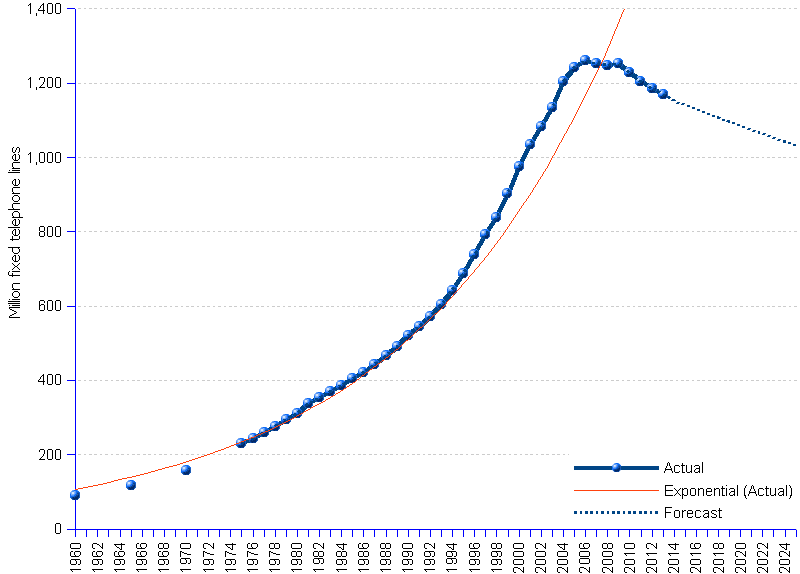

Main (fixed) telephone lines worldwide are past their 2006 peak of 1,261 billion, and initiated a decline that already brought the number of subscriptions down to 1.17 billion or 7% less in 2013, according to data from ITU (International Telecommunications Union) for the period 1960-2013 (actual data : blue dots; forecast : dotted line).
The chart provides a sobering example of the risk taken by forecasters : a sudden technological breakthrough — or a social or economic brutal change for that matter — may fundamentally alter the course of events in an unforeseeable way. In this case, the data followed an exponential growth path, typical of a logistic growth function (red line), until 1995. Growth even accelerated thereafter for a while. Fixed telephony seemed to have a radiant future.
However, the advent of the mobile cellular phone in the early 1980s became a rampant challenge to the fixed line's supremacy. The threat would become obvious with the implementation of the digital GSM protocol for cellular phones in the 1990s. Subscriptions to mobile phones rose fast, causing fixed lines to reach saturation at 1,261 million subscriptions in 2006, after which it was the downfall at the fast pace of -1.05% per year.
In fact, cellular technology may totally outstrip fixed telephony, just in the same way that telefax obliterated telegraph or Internet obliterated telefax.
Currently, cellular technology is capable of meeting and even surpassing fixed line data uploading performance. But it is not yet up to the task of providing data downloading at the same performance level, thus failing to meet requirements to deliver high speed, cost-effective and user-friendly Web browsing or massive data transfers. Telephone lines still do a better job in this respect — where the infrastructure exists —, and both interested businesses and individuals will continue to rely on them to get satisfaction. However, the blow inflicted on fixed lines by mobile telephony in 2001 as the latter became the universally preferred voice communication vehicle, may well replicate in the Internet realm and reduce fixed phone technology to niche application domains.
Main (Fixed) Telephone Lines | ||
Year | Telephone lines | |
Actual | Forecast ¹ | |
| 1960 | 90 | 90 |
| 1961 | ||
| 1962 | ||
| 1963 | ||
| 1964 | ||
| 1965 | 116 | 116 |
| 1966 | ||
| 1967 | ||
| 1968 | ||
| 1969 | ||
| 1970 | 158 | 158 |
| 1971 | ||
| 1972 | ||
| 1973 | ||
| 1974 | ||
| 1975 | 230 | 230 |
| 1976 | 244 | 244 |
| 1977 | 260 | 260 |
| 1978 | 276 | 276 |
| 1979 | 295 | 295 |
| 1980 | 312 | 312 |
| 1981 | 338 | 338 |
| 1982 | 353 | 353 |
| 1983 | 370 | 370 |
| 1984 | 387 | 387 |
| 1985 | 405 | 405 |
| 1986 | 422 | 422 |
| 1987 | 443 | 443 |
| 1988 | 467 | 467 |
| 1989 | 492 | 492 |
| 1990 | 520 | 520 |
| 1991 | 546 | 546 |
| 1992 | 572 | 572 |
| 1993 | 604 | 604 |
| 1994 | 643 | 643 |
| 1995 | 689 | 689 |
| 1996 | 738 | 738 |
| 1997 | 792 | 792 |
| 1998 | 838 | 838 |
| 1999 | 904 | 904 |
| 2000 | 975 | 975 |
| 2001 | 1,034 | 1,034 |
| 2002 | 1,083 | 1,083 |
| 2003 | 1,135 | 1,135 |
| 2004 | 1,204 | 1,204 |
| 2005 | 1,243 | 1,243 |
| 2006 | 1,261 | 1,261 |
| 2007 | 1,254 | 1,254 |
| 2008 | 1,249 | 1,249 |
| 2009 | 1,253 | 1,253 |
| 2010 | 1,228 | 1,228 |
| 2011 | 1,204 | 1,204 |
| 2012 | 1,186 | 1,186 |
| 2013 | 1,171 | 1,171 |
| 2014 | 1,153 | |
| 2015 | 1,141 | |
| 2016 | 1,130 | |
| 2017 | 1,119 | |
| 2018 | 1,108 | |
| 2019 | 1,097 | |
| 2020 | 1,086 | |
| 2021 | 1,075 | |
| 2022 | 1,064 | |
| 2023 | 1,054 | |
| 2024 | 1,043 | |
| 2025 | 1,033 | |
| ¹ Substitution forecast | ||
Sources: ITU International Telecommunications Union